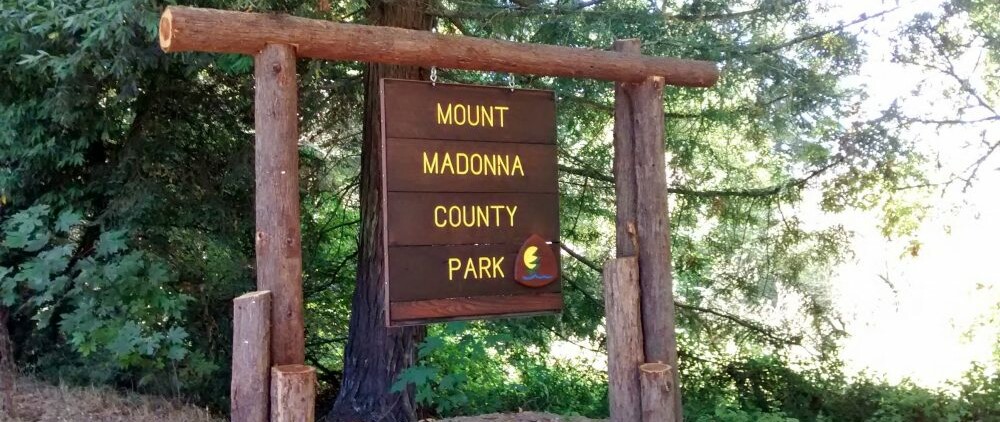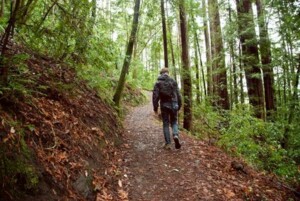Hike with Mike . . . with Mike Monroe: The origin of the name ‘Mt. Madonna’ is shrouded in deep mystery
Since 1803 there had been many land ownership and boundary disputes

By Mike Monroe

Mike Monroe
How the name “Mt. Madonna” became associated with the 1,897-foot peak in the southern Santa Cruz Mountains is the telling of a tale, rather than a confirmed historical account. The story is shrouded from view just as the peak is obscured by the blankets of fog that flow over Hecker Pass in the summer.
Inferring from the 1876 Thompson and West Santa Cruz County map, a man by the name of Moore owned the estimated 100 acres around the summit, but the peak was not identified on the map. Henry Miller’s name does frequently appear on this map as he was voracious in his desire to acquire land. However, in 1876 this remote corner of Rancho Las Animas was not yet in his possession.
The southern end of the Santa Cruz Mountains was originally referred to as the “French Redwoods.” The 1876 Thompson and West map indicates a road leading to the French Redwoods was an extension of what today is known as Castro Valley Road. It is possible that French name is connected with a family who were early pioneers in the San Felipe Lake area.
It is doubtful that any serious redwood logging occurred in the French Redwoods until George H. Bodfish and his brother Orlando purchased a portion of the French Redwoods in 1855. Such a purchase would suggest that a section of Rancho Las Animas, originally granted to the Castro family in 1803, was sold to the French (either an individual or a family). The 1876 Thompson and West map is clear when it identifies the firm of Whitehurst and Hodges as the subsequent owners of much of the French Redwoods, following the ownership periods of the Bodfish Brothers and William Hanna.
 According to Toby Echelberry in his biography of George Homer Bodfish: “Logging technology was relatively primitive in the mid-1850s, as the trees were cut with manual labor and the milling was done in huge saw pits. The Bodfish Mill in the French Redwoods was soon improved with the addition of a steam engine which boosted production dramatically. In 1862, the Bodfish Brothers began to associate their business with William Hanna, and expanded their milling output and acreage available for harvesting. At this time, the Bodfish Mills were providing most of the lumber to all of the homes and businesses being erected in Gilroy as well as delivering, by oxen and wagons, to areas further out such as San Juan Bautista and Monterey. In 1867, George Bodfish decided to pursue another of his interests in the mining business and sold the lumber operation to William Hanna. Unfortunately, his brother Orlando had become an alcoholic and took his own life in 1868.”
According to Toby Echelberry in his biography of George Homer Bodfish: “Logging technology was relatively primitive in the mid-1850s, as the trees were cut with manual labor and the milling was done in huge saw pits. The Bodfish Mill in the French Redwoods was soon improved with the addition of a steam engine which boosted production dramatically. In 1862, the Bodfish Brothers began to associate their business with William Hanna, and expanded their milling output and acreage available for harvesting. At this time, the Bodfish Mills were providing most of the lumber to all of the homes and businesses being erected in Gilroy as well as delivering, by oxen and wagons, to areas further out such as San Juan Bautista and Monterey. In 1867, George Bodfish decided to pursue another of his interests in the mining business and sold the lumber operation to William Hanna. Unfortunately, his brother Orlando had become an alcoholic and took his own life in 1868.”
The Hermmann Bros. Map of 1889 gives Mt. Madonna a place name. The Whitehurst and Hodges partnerships still owned substantial redwood lands near Mt. Madonna and now showed that Henry Miller’s had acquired about 1,800 acres including the summit area. There is not much information available as to what was happening at Mt. Madonna during the interval from 1876 to 1889 except to conclude that logging of the old growth redwoods was in full swing. Some of the logging was conducted by a Gilroy resident by the name of Hiram Wentworth. Scant information about Wentworth exists. Supposedly he owned some acreage at Mt. Madonna (unknown quantity) and Henry Miller purchased his property in either 1873 or 1875. This does agree with the Thompson and West Map (1876) though.
 It must be remembered that since 1803 when the Castro’s received the initial grant for Rancho Las Animas there had been many land ownership and boundary disputes. The tangle of claims forced a “friendly” legal action known as the Las Animas Partition suit which began in 1879 and did not conclude until 1887. Even though Henry Miller made his first 200-acre purchase of Rancho Las Animas in 1859, and that the community of Gilroy was within the grant boundaries, none of the titles could be confirmed. Maybe it was for this reason that Henry Miller did not build his mansion at Bloomfield Ranch until 1888 when he knew that his title was secure.
It must be remembered that since 1803 when the Castro’s received the initial grant for Rancho Las Animas there had been many land ownership and boundary disputes. The tangle of claims forced a “friendly” legal action known as the Las Animas Partition suit which began in 1879 and did not conclude until 1887. Even though Henry Miller made his first 200-acre purchase of Rancho Las Animas in 1859, and that the community of Gilroy was within the grant boundaries, none of the titles could be confirmed. Maybe it was for this reason that Henry Miller did not build his mansion at Bloomfield Ranch until 1888 when he knew that his title was secure.
 The exact date for Henry Miller’s purchase of Mt. Madonna is not known nor even the seller. We do know that in December 1885 Hiram Wentworth wrote President Grover Cleveland asking the president to review his claim to a portion of the Las Animas Rancho. Wentworth referred to the lawsuit as a “ridiculous farce” instigated by Henry Miller implying a land grab. The Gilroy Advocate reported Wentworth’s anger, saying “I wish Mr. Miller to be thoroughly convinced that at least once in his life he attempted to rob the wrong man of his land.” Apparently Judge Belden who was managing the lawsuit ruled in favor of Henry Miller as the legal owner of Mt. Madonna.
The exact date for Henry Miller’s purchase of Mt. Madonna is not known nor even the seller. We do know that in December 1885 Hiram Wentworth wrote President Grover Cleveland asking the president to review his claim to a portion of the Las Animas Rancho. Wentworth referred to the lawsuit as a “ridiculous farce” instigated by Henry Miller implying a land grab. The Gilroy Advocate reported Wentworth’s anger, saying “I wish Mr. Miller to be thoroughly convinced that at least once in his life he attempted to rob the wrong man of his land.” Apparently Judge Belden who was managing the lawsuit ruled in favor of Henry Miller as the legal owner of Mt. Madonna.
So the extent of Hiram Wentworth’s activity at Mt. Madonna is uncertain. His logging operation may have been extensive or not. One report suggested that he sold his downed logs to both Gilroy and Watsonville mills. The story of Mt. Madonna’s name does link to Wentworth — amongst his logging crew were some Italians who conveyed their Catholic faith by calling the mountain “Madonna” referencing Mary the mother or Jesus. Perhaps it was their view of the mountain from Gilroy that reminded them of Mary’s arms embracing Jesus just as Mt. Madonna’s sloping sides invite visitors today.
One last note about Hiram Wentworth. His departure from Gilroy was in early 1886. His wife left him and she traveled to San Diego while engaged in an extramarital affair. He went after her and there was an attempted reconciliation that apparently failed as in April 1887 he wrote and published a long poem of his ordeal. The poem was entitled “Sold by His Wife in Mexico” with the author as “The Bard of Mount Madonna.” The cover of the pamphlet, which is held by the Library of Congress, quotes Shakespeare and Tennyson and for this reason Hiram Wentworth is still referred to as the reclusive poet of Mt. Madonna.
